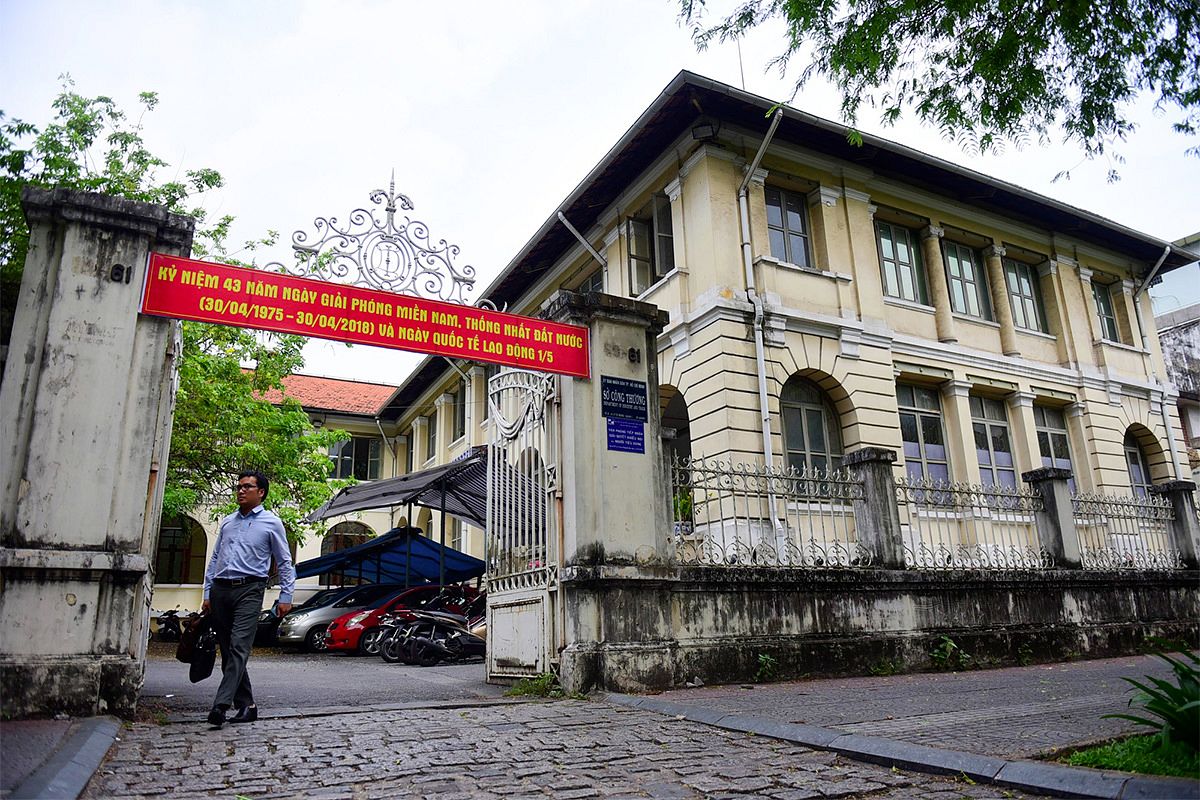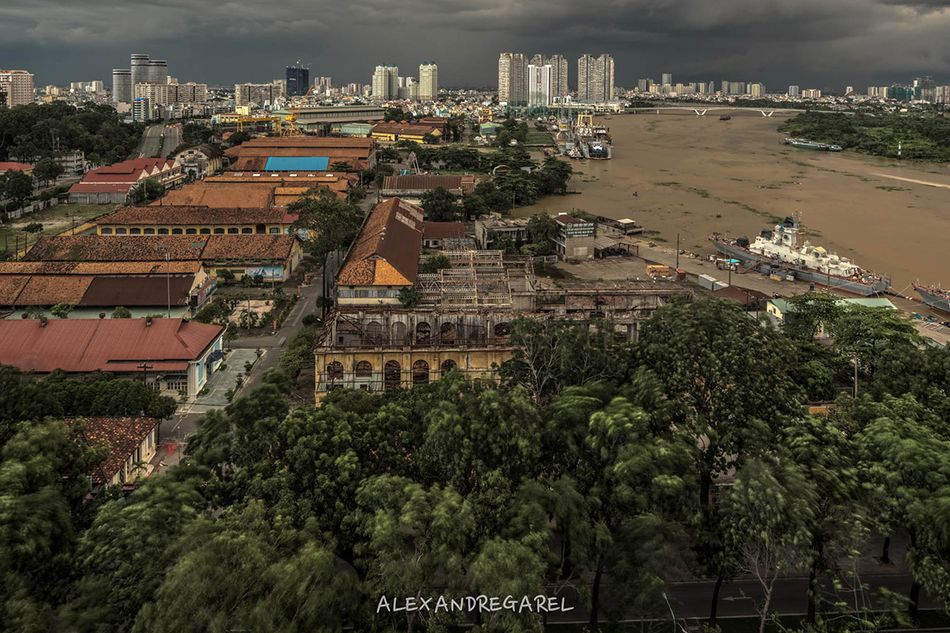Chi Hoa Prison (Khám Chí Hòa) is a seven-hectare facility located in Saigon's District 10.
According to VnExpress, in 1943, to replace the Saigon Grand Prison, construction of Chi Hoa was initiated by the Japanese — who withdrew from Vietnam before its completion — and later finished by the French. On March 8, 1953, as the construction of the prison came to an end, the Saigon Grand Prison was demolished. Aside from a number of released prisoners, the remaining 1,600 were transferred, along with a guillotine, to Chi Hoa.

Screenshot of an image of a model of the prison before it was built. Photo via Good Morning Magazine.
Lâm Chí Hiếu, a writer for the Good Morning Magazine, wrote in 2012 that Chi Hoa has long been a feng shui symbol to "control evil forces" in Saigon, and also a highly appreciated architectural work, as it harmonizes the hallmark traits of French architecture with the mystical aspects of Eastern philosophy. The Japanese architect responsible for Chi Hoa's design supposedly structured it on the theory of the eight trigrams, thus building the prison in an octagonal shape to render it as a bagua (bát quái) map that can trap malicious forces. Each side of the octagon is an area to house detainees, the backs of which form a continuous wall that seems to seal the prison shut - save for the entrance gate, which connects to the inside only through a small, secure tunnel.
Some sources note that the eight equal sides of Chi Hoa's walls represent the eight trigrams in Kinh Dich (I Ching, or the Book of Changes, an ancient Chinese divination text): Càn (Qian), Khôn (Kun), Chấn (Zhen), Tốn (Xun), Cẩn (Gen), Khảm (Kan), Đoài (Dui), and Ly (Li). Out of these eight trigrams, Qian represents the sky and is said to correspond with the location of the gate. This is supposedly why Leigong, the God of Thunder in eastern folk religion, mythology and Taoism, often “visits" the prison in the form of lighting strikes on the gate, for example in the years 1956, 1964 and 1965.

Chi Hoa Prison's imposing entrance gate. Photo via Thoi Moi.
Others claim that the prison was built based on the Stone Sentinel Maze designed by Zhuge Liang (courtesy name Kongming), chancellor and regent of the Chinese state of Shu Han, as well as an inventor, engineer and writer. In The Romance of the Three Kingdoms by Luo Guanzhong, Zhuge Liang used the concept of bagua to design the Stone Sentinel Maze, which successfully halted his enemies. The maze contains eight gates: Hưu (Gate of Healing), Sinh (Gate of Life), Thương (Gate of Pain), Đỗ (Gate of Limit or Gate of Closing), Cảnh (Gate of View or Gate of Joy), Tử (Gate of Death), Kinh (Gate of Wonder or Gate of Shock), and Khai (Gate of Opening).

Zhuge Liang from Wanxiaotang Huazhuan, a book written by Zhou Sangguan published in 1743.

The Stone Sentinel Maze from Three Kingdoms, a 2010 Chinese television series directed by Gao Xixi.
Prisoners have claimed that the entrance area corresponded with the Gate of Death. This is to ensure that ordinary people (those not well-versed in the art of divination) who enter will lose their way and find themselves unable to leave — like straying into a maze. However, according to masters of divination, such an alignment fills the area with yin energy and brings a miasma of resentment over the prison, as the souls of prisoners who pass away there cannot escape and be reborn. The masters conclude that the continuous lightning strikes are a sign from Heaven to open the Gate of Life and free these spirits.
Some scientists voiced their belief that an ore mine under the building is what attracts the lightning, but fear of restless spirits prevails nonetheless. President Ngô Đình Diệm was said to have also advocated for the opening of the Gate of Life: he invited a highly skilled master of divination to “neutralize" the yin energy in Chi Hoa Prison. This master then advised that one of the eight roofs be leveled down, thus breaking up the perfect design of the prison to allow souls to pass on after death.
In another effort to release the entrapped yin energy, in 1954, the officer in charge of Chi Hoa had a Buddhist temple built just outside the bagua map, but still within the premises of the prison. The temple was later demolished, and the statue of Buddha is now located on a small lake. Within the site of the prison, there is also a church (now used as the prison’s hall) built by the French as a place to baptize prisoners before their execution.

An exterior view from the prison, with the water pump/watchtower at the center of the courtyard visible. Photo via We25.
Inside Chi Hoa Prison, every corridor and passageway is designed according to cung vị, the temporal and spatial location of things. At the heart of the prison is a large courtyard, which contains a water pump that acts as a watchtower at the same time. When viewed from above, the tower bears the shape of a sword planted into the ground, and it is thus often called tru tiên kiếm — a spiritual sword that supposedly contains the supreme power to slice open the sky, destroy the earth, kill gods, and annihilate demons. Anecdotes about Chi Hoa Prison often highlight the key role of this sword: criminals at Chi Hoa, no matter how cunning or sly, could not escape from it. If tru tiên kiếm was somehow removed from the earth, the entirety of the elaborately designed eight-side map would crumble upon itself.
Chi Hoa Prison's tale of enigmatic divinations and mystical arts remains widespread to this day, for history has acted as a testament to its spiritual power: there have only been three successful escapes from Chi Hoa since it was built. The first was a group of revolutionary soldiers in 1945, who took advantage of the chaos that ensued when the Japanese overtook French rule. The second was the bandit Điền Khắc Kim in 1972, and the third was the infamous death row inmate Phước "Eight Finger" in 1995.















